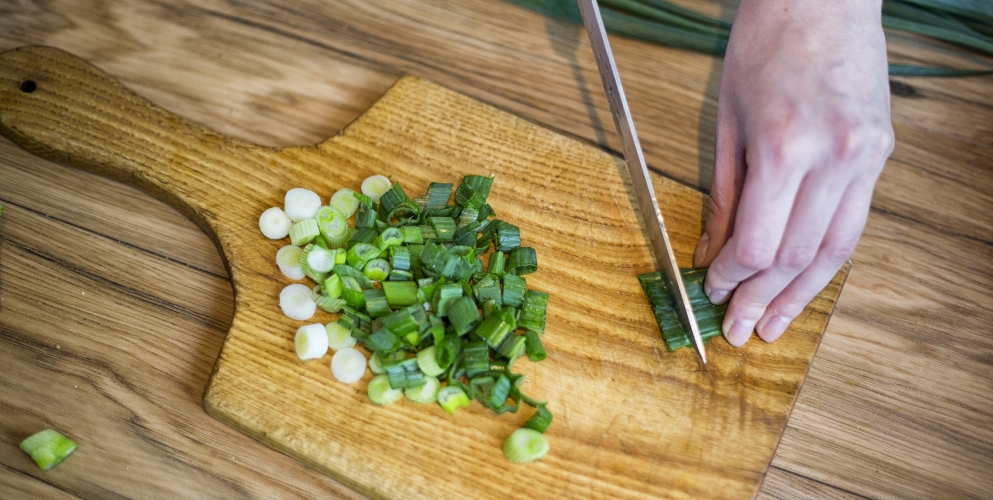Christmas & New Year Trading
Website: Open 24/7 for on-line ordering.
Customer Service/Warehouse: Closed 12pm Monday 23rd December 2024, re-opening 8:30am Thursday 2nd January 2025.
All orders placed over the holiday period will be processed in the New Year.
We wish all of our customers a Merry Christmas and a Happy New Year.
Santoku Knives vs Chefs Knives
Which is the best choice for your food prep?
Santoku knives and chef’s knives are the ‘go-to’ knives for many professional chefs as they are versatile enough to perform a range of tasks in the kitchen. Technically Santoku knives are a type of chef’s knife but they vary in shape and style to the traditional French and German style knives.
The main difference between a santoku knife and a chef's knife is that santoku knives are better suited to precision cutting, where you need really thin cuts. It's harder to achieve the same level of precision with a chef's knife. Santoku knives also require a different technique slicing through the food in a forward and backward motion, whereas a standard chef's knife requires a rocking back and forth motion. Keep in mind that there are various different styles of chef's knives.
In this article we take a look at the difference between these two types of knives, looking at performance; blade length, material and style; and handles.
An introduction...
Santoku knives or to give them their full name Santoku bocho knives, which translates as ‘three uses’, are ideal for mincing, dicing and slicing, as they feature a straight edge with a narrow sheep’s foot blade. These knives have evolved from the traditional Japanese vegetable knife which has a rectangular blade.
French or German style chef’s knives have a curved edge which gives the blade a rocking motion when chopping against a board and the long blade is also capable of slicing through meat. Chef’s knives are seen as a universal kitchen tool used for a range of different tasks. It’s important to note that there are subtle differences between French and German style knives. French knives tend to have a flatter shape at the heel of the blade which gradually reaches towards the point, whereas the profile of a German style edge has more of a curved blade.
Style and Performance
For most chefs, the most important aspects of a knife is its style and performance. Style refers to the shape and design of the knife and performance refers to its sharpness and how it performs in use.
Santoku knives

Some Santoku knives are sharpened on one side of the blade only. This is the traditional Eastern way and enables the chef to have greater control over the direction of cutting. Most Santoku knives are a hybrid of West meets East, in that the shape of the blade is curved with a flat cutting edge and the sharpening is 50/50 on either surface. This makes for easier sharpening and maintenance with a traditional steel or pull through sharpener.
A Santoku knife is ideally suited to precision work thanks to the light, narrow blade, which can make thinner cuts, as less food has to be pushed out of the way as the blade makes each slice. Japanese knives require a different technique to Western knives in that they slice through food in a forward and backward motion, rather than Western knives which require a rocking motion, which generally creates thicker slices and takes longer to cut than the quicker Santoku blade.
Chef’s knives

French and German style knives tend to have a straight edge which has a slight curve from the heel to the tip of the blade. The main advantage of chef’s knives over Santoku knives, when it comes to performance, is that the blades are robust enough to carve through meat as well as fish, fruit and vegetables.
The thin, flexible blade and sheep’s foot tip of Santoku knives means they don’t cope well with tougher jobs such as deboning meat, plus the harder steel of the Santoku blades makes them more prone to chipping. The same can be said for cutting through tough vegetables such as butternut squash and turnips. For many professionals and home cooks, the chef’s knife is the best all-round knife for a complete range of food preparation tasks.
Other points to consider…
Blade Length
Santoku knives have a shorter blade than chef’s knives and are about 6 inches long, this shorter blade provides more control which can be particularly useful for less experienced chefs. The average length blade for a chef’s knife tends to be 8 inches but can be as long at 14 inches.
Blade Material
The majority of kitchen knife blades are made from stainless steel but the type and finish of the steel used depends on the manufacturer. For example, prominent Santoku manufacturer Kai create their Shun Classic range of knives from highly refined corrosion resistant V-Gold-10-series steel within a Damascus cladding. V-Gold-10-series steel is produced in Japan and is a strong high carbon steel which offers the corrosion resistance of stainless steel as well.
Western knives tend to be made of softer, but tougher, steel and have thicker blades, the softness of the steel means that the blades need sharpening more frequently. It’s the softness of the steel blade that makes chef’s blades less prone to chipping. The toughness of the blade can make them feel heavy though which, depending on your personal preference, may be a good or bad feature of the knife.
Handle
Traditional Santoku knives don’t usually feature a bolster, which is a typical feature of a German or French handle. As a bolster can help protect your hand from slipping down the blade and provide more grip, anyone new to using professional knives will likely benefit from choosing a blade with a bolster.
Both knives are usually made with a full tang which offers a balanced feel.
Which style of knife is best?
Ultimately, the knife you choose will be the one that suits your grip and cookery style best. If you cook a certain type of food, for example a menu heavy on fish, fruit and vegetables, but with less meat, then a Santoku knife would be the better choice. If you’re looking for a robust all-rounder which can carve meat and cut small bones as well as fruit and vegetables then a chef’s knife is best. If you’re spending a lot of time in the kitchen, producing a variety of dishes then it’s worth splashing out on both knives.
Again, the brand of knife you choose will depend on personal preferences, but the below are solid options if you’re looking to upgrade your knife collection.

French – Sabatier is the name synonymous with quality French knives and the 25cm Sabatier Cooks Knife is an excellent choice for a chef’s knife under £40.

German – If you prefer a blade with a bit more curve to it, then the 20cm Wusthof Classic Cooks Knife is a sturdy knife manufactured by the famous German brand.

Santoku – The 13 cm Kasumi Santoku Knife has a short blade which offers the ultimate level of control when precision slicing.
17 June 2016





